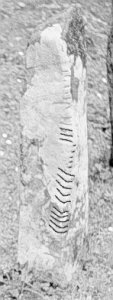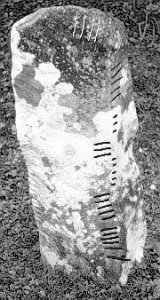According to the same author, Pelham "appears to have discovered five of the inscribed stones" at the site which he "represents .. as a low Cairn flat on the top, the stones being in a circle". Human bones were found "on digging round their bases", as Hitchcock reported (in Ulster Journal Arch. V, I, 104; n.v.). The site is accordingly mentioned in Brash, JRSAI 16, 1884, 128 because of being a "pagan cemetery". Ferguson, however, stated that it could not be determined "whether the site was a cealluragh or a cemetery attached to a church" (OI, 42).
The site was visited by Windele in 1838 who "found on the Cairn seven inscribed stones" (Brash, OIM) and made a "highly characteristic sketch" of the place (Ferguson, OI 42). By his second visit, in 1848, three of the stones {148, 149, 150} had been removed by Lord Ventry to his seat in Burnham, where they are still today, together with a fourth one {151} that had been stored in "Lough near Ballintaggart" until 1870 at least (cf. Ferguson, OI 43 and Brash, OIM 210, according to whom this was at "Lough House, within a quarter of a mile from Dingle, the residence of the Rev. Richard Chute) and with two stones from different localities [{147} and {175}]. Two other stones from Ballinrannig [{152}, {153}] were transferred to Chute Hall near Tralee, the residence of Lord Ventry's son-in-law, Richard Chute. The seventh stone {154} remained on the site: "it was for long buried in sand" (so that it was not visible to Macalister when preparing Epig. 1: cf. p. 27), but was later "re-erected on a knoll, at or near the original site". Brash visited Burnham in July 1868 (but not the original location in Ballinrannig, it seems).
When visiting this spot in 1978, the remaining stone {154} was still standing upright, but by 1981 another storm had affected it so that it was nearly lying prostrate again (this happened in winter 1979 according to Sheehy, Dingle 52). Further damage is probable because the site is crowded by campers in the summer time.
Another "(fragmentary) stone" from the site was recorded in Hitchcock's and Graves's notebooks; it was assigned {154A} in Macalister's CIIC.
Size according to Brash, OIM 208 (no. 1): 3'10" above ground, x 13" x 8"
Size according to Macalister, CIIC: 3'5 1/2" x 1'10 1/2" x 0'8"
- Published illustrations:
- Brash, OIM pl. XXVI, no. 1 (draft)
- Macalister, CIIC I, 145 (draft).
Reading Brash, OIM 208:
Left angle:
îìâòñòñåäîìåãêè
CARRICES
Right angle:
ïâîíîíåäíåãêéâîí
MAQQITENAC
"CARRICES THE SON OF TENAC"
Reading Ferguson, OI 44 (64.):
MAQQITENAC
GILLAMURRas
Reading Macalister, Epig. 1, 27 (6.):
Left:
îìâòñòñåäîìâåä
CARRICAI
Right:
ïâîíîíåäíåãêéâîìä..
MAQQITENACi
Reading Macalister, CIIC:
DUBONIRRAS MAQQI TENAC[I]
Interpretation Korolev, DP 76:
DUBONIRRAS/MAQQI TENACI&127;
Reading McManus, Guide 65:
DUBONIRRAS MAQQI TENACi
Reading Gippert (1978):
 Dexter angle down (?) -
Dexter angle down (?) -  Sinister angle up:
Sinister angle up:
(DUB)[O](N)IRR(A)[S] || MAQQI TE(N)[A](C)[
(ìäç)[ã](êé)åäòñòñ(â)[êè] || ïâîíîíåäíåãê(é)[â](îì)[
(ëëâââçâ)[â](çç)çççâââââïïïïïæïïïïï(â)[çççç] || ïâëëëëëâââââëëëââââçççç(ç)[â](ëëëë)[
Additional literature:
Vallancey, Collectanea 6, 226: H. Pelham Ulster Journ.Arch. V. I. p. 104: Hitchcock (acc. to Brash, OIM 208)Last changes of this record: 27.04.97
Copyright Jost Gippert, Frankfurt a/M 1996. No parts of this document may be republished in any form without prior permission by the copyright holder.


